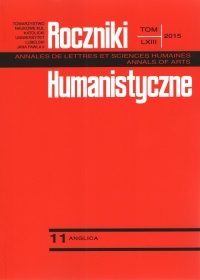Licensing of vowel quantity and the Scottish vowel length rule
Abstrakt
Licencjonowanie jakości samogłoski a zasada długości szkockiej samogłoski
Autor artykułu wykazuje, iż dystrybucja długich samogłosek w szkockim dialekcie języka angielskiego jest uzależniona od dwóch czynników. Pierwszym jest złożoność spółgłoski następującej po potencjalnie długiej samogłosce. Im bardziej złożona jest spółgłoska, tym mniejsza możliwość licencjonowania długości. Drugim czynnikiem jest aktywność elementu A w licencjonowanej samogłosce. Im mniej aktywny jest element A, tym większa potrzeba licencjonowania. Interakcja tych dwóch czynników jest odpowiedzialna za obecność lub brak obecności długich samogłosek w pewnych kontekstach.
Bibliografia
Anderson, John. 1993. Morphology, phonology and the Scottish Vowel-length Rule. Journal of Linguistics 29, 419-430.
Anderson, John. 1994. Contrastivity and non-specification in dependency phonology. Studia Anglica Posnaniensia 28, 3-35.
Backley, Phillip. 2011. An Introduction to Element Theory. Edinburgh: Edinburgh University Press.
Booij, Geert. 1995. The Phonology of Dutch. Oxford: Oxford University Press.
Carr, Phillip. 1992. Strict Cyclicity, Structure Preservation and the Scottish Vowel-Length Rule. Journal of Linguistics 28, 91-114.
Carr, Phillip, Jacques Durand and Monika Pukli, 2004. The PAC project: principles and methods. In Phillip Carr, Jacques Durand and Monika Pukli (eds.), English Pronunciation: Accents and Variation, [Special issue] La Tribune Internationale des Langues Vivantes 36, 24–35.
Charette, Monik 1991. Conditions on Phonological Government. Cambridge: Cambridge University Press.
Cyran, Eugeniusz. 2010. Complexity Scales and Licensing in Phonology. Berlin: Moulton de Gruyter.
Durand, Jacques. 2004. English in early 21st century Scotland: a phonological perspective. In Phillip Carr, Jacques Durand and Monika Pukli (eds) English Pronunciation: Accents and Variation, [Special issue] La Tribune Internationale des Langues Vivantes 36, 87–105.
Ewen, Collin. 1977. Aitken’s Law and the phonatory gesture in Dependency Phonology. Lingua 41. 307-29.
Goldsmith, John. 1990. Autosegmental and metrical phonology. Oxford: Basil Blackwell.
Gussmann, Edmund. 2007. The Phonology of Polish. Oxford: Oxford University Press.
Harris, John. 1985. Phonological Variation and Change: Studies in Hiberno-English. Cambridge: Cambridge University Press.
Harris, John. 1994. English Sound Structure. London: Blackwell.
Harris, John. 2006. The phonology of being understood: further arguments against sonority. Lingua 116, 1483-1494.
Hooper, Joan. 1976. An Introduction to Natural Generative Phonology. New York: Academic Press.
Kamińska, Tatiana. 1995. Problems in Scottish English Phonology. Tübingen: Niemeyer.
Kaye, Jonathan, Jean Lowenstamm & Jean-Roger Vergnaud. 1990. Constituent structure and government in phonology. Phonology 7. 193-232.
Krämer, Martin. 2009. The Phonology of Italian. Oxford: Oxford University Press.
Lass, Roger. 1984. Phonology: An introduction to basic concepts. Cambridge: Cambridge University Press.
Lehiste, Isle. 1970. Suprasegmentals. Cambridge, Massachusetts: The MIT Press.
Lowenstamm, Jean. 1996. CV as the only syllable type. In Jacques Durand and Bernard Laks (eds.), Current trends in Phonology. Models and Methods. Salford, Manchester: ESRI. 419- 441.
McKenna, Gordon. 1988. Vowel Duration in the Standard English of Scotland. Unpublished MLitt thesis, University of Edinburgh.
McMahon, April. M. S. 1991. Lexical phonology and sound change: the case of the Scottish vowel length rule. Journal of Linguistics 27, 29-53.
McMahon, April. M. S. 2000. Lexical Phonology and the History of English. Cambridge: Cambridge University Press.
Noske, Roland, Jos Shinkel and Norval S. H. Smith. 1982. The Question of Rule Ordering: Some Counter-Fallacies. Journal of Linguistics 18(2). 389-408.
Pukli, Monika. 2006. Investigation sociophonétique de l’anglais en Ecosse : le cas de Ayr. Universite Toulouse II – Le Mirail dissertation.
Scheer, Tobias. 1998. Governing domains are head-final. In Eugeniusz Cyran (ed) Structure and Interpretation. Lublin: Folium, 261-285.
Scheer, Tobias. 1999. On constraints vs. non-circular approaches to word-initial clusters. In John Rennison and Klaus Kühnhammer (eds.), Phonologica 1996, The Hague: Holland Academic. 289-304.
Scheer, Tobias. 2004. A Lateral Theory of Phonology: What is CVCV, and why should it be? Berlin: Moulton de Gruyter.
Scobbie, James and Jane Stuart-Smith. 2006. Quasi-phonemic contrast and the fuzzy inventory: Examples from Scottish English. QMUC Speech Science Research Centre Working Papers. WP-8.
Scobbie, James, Alice Turk, and Nigel Hewlett. 1999. Morphemes, phonetics and lexical items: the case of Scottish Vowel Length Rule. In John Ohala, Yoko Hasegawa, Manjiari Ohala, Daniel Granville, and Ashlee Bailey (eds) Proceedings of the 14th International Congress of Phonetics Sciences. San Francisco. 1617-1620.
Scobbie, James, Nigel Hewlett, and Alice Turk. 1999. Standard English in Edinburgh and Glasgow: the Scottish Vowel Length Rule revealed. In Paul Foulkes and Gerard Docherty (eds.), Urban voices: Accent studies in the British Isles. London: Arnold. 230-245.
Selkirk, Elisabeth. 1982. The syllable. In Harry. van der Hulst and Norval Smith (eds.), The structure of phonological representation, part II. 337-383.
Sundkvist, Peter. 2010. Scottish Standard English as spoken in Lerwick: an overview of pronunciation features. In Robert McColl Millar, (ed.), Northern Lights, Northern Words. Selected Papers from the FRLSU Conference, Kirkwall 2009. Aberdeen: Forum for Research on the Languages of Scotland and Ireland, 98-106.
Zdziebko, Sławomir. 2012. Issues in Scottish Vowel Quantity. Newcastle-upon-Tyne: Cambridge Scholars Publishing.
Copyright (c) 2015 Roczniki Humanistyczne

Utwór dostępny jest na licencji Creative Commons Uznanie autorstwa – Użycie niekomercyjne – Bez utworów zależnych 4.0 Międzynarodowe.





